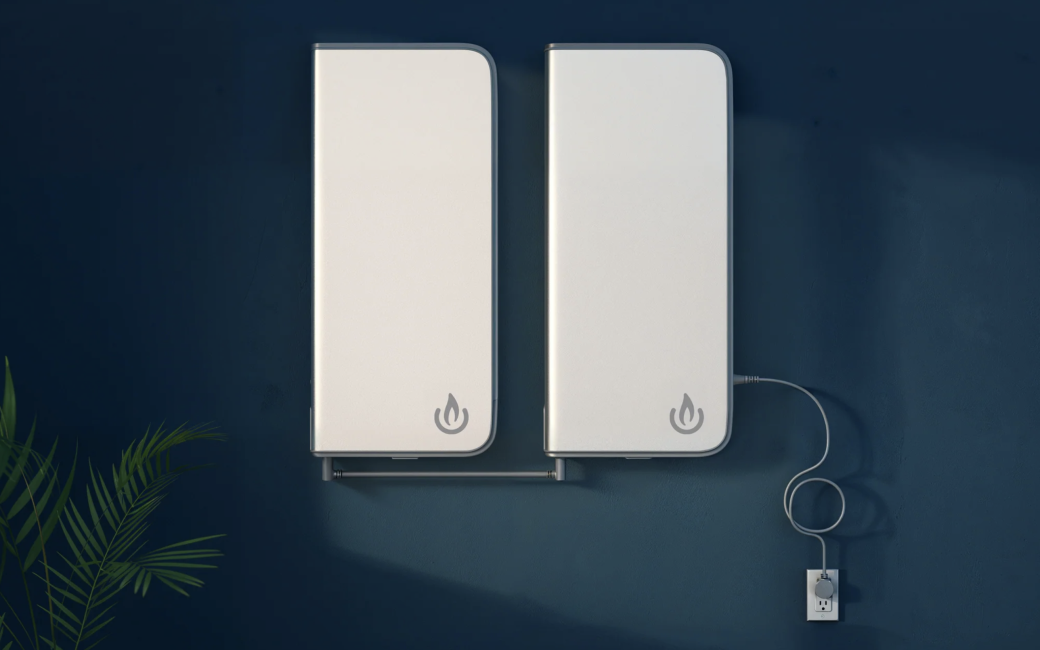Allison interviews Erica Rosen from BioLite about their backup solutions designed for the home. BioLite batteries provide automatic backup energy to power your home essentials for up to 24 hours.
Unlike other home backup solutions, BioLite is a DIY install that takes only 30 minutes. It has an ultra-slim design that is quiet and designed to disappear. For example, they are thin enough to fit behind refrigerators in most homes.
Each BioLite stores up to 1.5kWh of energy and can supply 1,200W of continuous power and 2,400W of surge power through three standard AC ports. BioLites can be configured with multiple units to store up to 10.5kWh of total energy.
BioLite is available for pre-order at the link below and should ship in the summer of 2025.
Learn more at https://bioliteenergy.com
Using a Screen Reader? click here
Transcript of Interview:
Allison: Well I saw a refrigerator here at CES and I’m not used to seeing that but this is not about the refrigerator at all. I’m here with Erica Rosen from BioLite. What are we doing here today?
Erica Rosen: Okay, so the fridge is here as a bit of a prop because it’s being powered completely off-grid by backup. Backup is an automatic backup energy system that you can install yourself in under 30 minutes. It’s a safety net between appliances that you need to keep running and the grid, so when the grid goes down, things like your fridge stay up and running, your life is undisrupted, and you go about your business.
Allison: So this is video but also an audio podcast, so describe the size and shape of what we’re looking at.
Erica Rosen: Absolutely, so for the backup system, what you are looking at right here are two rectangular metal tablets that are on the wall, and these are basically very skinny, very smart batteries. These are energy storage systems that they install directly onto the wall, and they’re designed to live in forgotten spaces. So I think for folks who are listening, yes, it’s a long rectangular battery, but it’s only 2.8 inches thick, and that’s because we have a state-of-the-art inverter in here that is the thinnest inverter of any kind, so whatever a wall outlet can do this can do and it takes a lot of science to make that happen.
Allison: That’s just on 110 those have been charged up?
Erica Rosen: Yep, yep, yep, yep. So this is a three-kilowatt-hour solution. It can output 1,800 watts of power with a 3,000-watt surge, so if you know the compressor on your fridge kicks on with no problem, it can handle it.
Allison: I always make the joke on things like that is that that can even do a laser printer.
Erica Rosen: Oh, I’m gonna have to check out the power specs. I’ll get back to you.
Allison: Yeah, well, you can’t put them on a UPS because the power surge is too much, but this is like that, so yeah, those are actually really pretty I mean, I would not try to spot them on the wall in my kitchen, but would you be putting these so you were saying forgotten spaces like in a coat closet or something?
Erica Rosen: Yeah, yeah, yeah, so these are designed, as I said, to live in forgotten spaces, and one of the most forgotten spaces is behind your fridge. If you can believe it, there’s about a three to four-inch clearance behind refrigerators. Most fridges allow this to slide right back there. I’m sure for people listening, they may be like doesn’t it get hot back there? Isn’t it dusty? Yes, and we designed for that. This is a fully enclosed solution, and the back of the unit is actually a giant heat sink so we are able to manage any sort of ambient temperatures so that it doesn’t just live in that space it thrives in that space it’s gonna do just fine.
Allison: So do you sell them in pairs or can you buy one? How does that work?
Erica Rosen: Yeah, so the unit that is on the wall right now is what we call the complete kit, and it’s comprised of the core unit that is the brains of the operation that has battery plus an inverter, and then it has an extend unit. That is just an extra energy reserve. So the complete kit is three-kilowatt hours, but you can buy the core unit as a standalone, or you can add additional extend units onto the system up to a 10.5-kilowatt hour solution.
Allison: Okay, so let’s say I have this in my house, and I find that extra space behind my refrigerator. I put it in there. How do I plug things into this?
Erica Rosen: Yes, yes, yes. Should we walk across? Come on over…yeah, so if you come over here, I can show you over on this side. So you have the input so you plug it into the wall, and that goes right here, and then there are two AC ports, and so those AC ports are where you can plug devices directly into backup. But let’s say you’re like I have I have more than two things I need to be protected. No problem; every system comes with a magnetic extension cord, so you can plug in a USB.
Allison: It looks like a surge protector USB.
Erica Rosen: Yes, it’s a power strip, so basically, if you have more than two things you want plugged in that need automatic protection, you can plug them into this strip with no problem.
Allison: Okay so this isn’t for powering your whole home but a few devices that are near each other.
Erica Rosen: Correct. This is designed to be an in-room solution. If you look at this, for example, with the fridge, one of the most important rooms in the home when the power goes out is your kitchen. You want to be able to keep your fridge running; you don’t want to lose all of your groceries, you know if you have milk, medicine, like medical, dog food.
Allison: Insulin.
Erica Rosen: Insulin. Exactly, exactly, and so when the power goes out, one of the places where people feel the most helpless is their fridge, and we want to keep your fridge running with no problem.
Allison: That is what we care about. I want to come around to this side of you now; I want to see that this is actually cold inside.
Erica Rosen: Yes, we have nice cool beverages in here, and we have. Oh, how did that get in there?
Allison: Oh, look at that. It’s a CES Innovation Award for home appliances!
Erica Rosen: I told them not to put it in there.
Allison: Oh that is that’s a cold soda.
Erica Rosen: Yep, and it’s all happening totally off-grid, and then if the power were to come back on, backup would automatically recharge itself.
Allison: So you don’t have to do anything.
Erica Rosen: Unlike some more portable solutions where you have to remember to charge it back up the minute the grid comes back on, this is gonna recharge itself. You don’t have to think about it.
Allison: Is there some sort of app so you know how much it charges?
Erica Rosen: Yes, there is an app that will communicate both locally via Bluetooth and Wi-Fi the cloud if the power goes out, it’ll notify you, and then you can also do things like schedule time of use, so let’s say you have you’re on a rating system with your utility company this is more of a secondary application but if you want to save a couple of cents here and there.
Allison: No, that matters a lot. Where I live, my rate is double during peak times.
Erica Rosen: Yeah, so you can run devices off this for a few hours every day during peak hours, and then you can end up saving some serious dollars by the end of the year.
Allison: Yeah that would not be too hard in LA pricing. Steve, I’m gonna do something I’ve never done before. Erica’s gonna stay here. I’m going behind the fridge to make sure she’s not cheating plugged into the wall. So I’m walking behind the refrigerator over here. Okay, I see I see a power line there, but it’s not going…nope we’re okay hang on we’re all running around now this is fun this is a full demo.
Erica Rosen: You can see that this is plugged into the inverter and so the power is running off of the whole system. So you can see that this light that’s blinking right now — all systems live.
Allison: Okay, and what about this black cable? Is that going to the wall outlet back there?
Erica Rosen: That’s the fridge.
Allison: Oh, that’s the fridge. Oh, okay, there we go. Yeah, all right, nothing up her sleeves, even though she does hide her rewards in the refrigerator.
Erica Rosen: That’s why I came, we’re in Vegas after all.
Allison: There you go, thank you very much, Erica. Oh, price point. Did you already tell me?
Erica Rosen: I don’t know, but I’ll tell you again, so the complete kit is \$3,000, but at a three-kilowatt hour installed solution, and again, this is an installed solution, it can qualify for a 30% tax credit, so you’re looking closer to a $2,100 out of pocket.
Allison: So l that’d be the federal tax credit? Wow, that’s all right. Availability?
Erica Rosen: Shipping this summer.
Allison: Oh, fantastic, and where would people go to find out more about BioLite?
Erica Rosen: Yeah come on over to BioLiteEnergy.com that’s B-I-O-L-I-T-E-Energy.com.
Allison: Very good, thank you very much. This is fun.
Erica Rosen: Yeah, thanks for your time.


[…] CES 2025: Biolite Backup Energy Systems […]